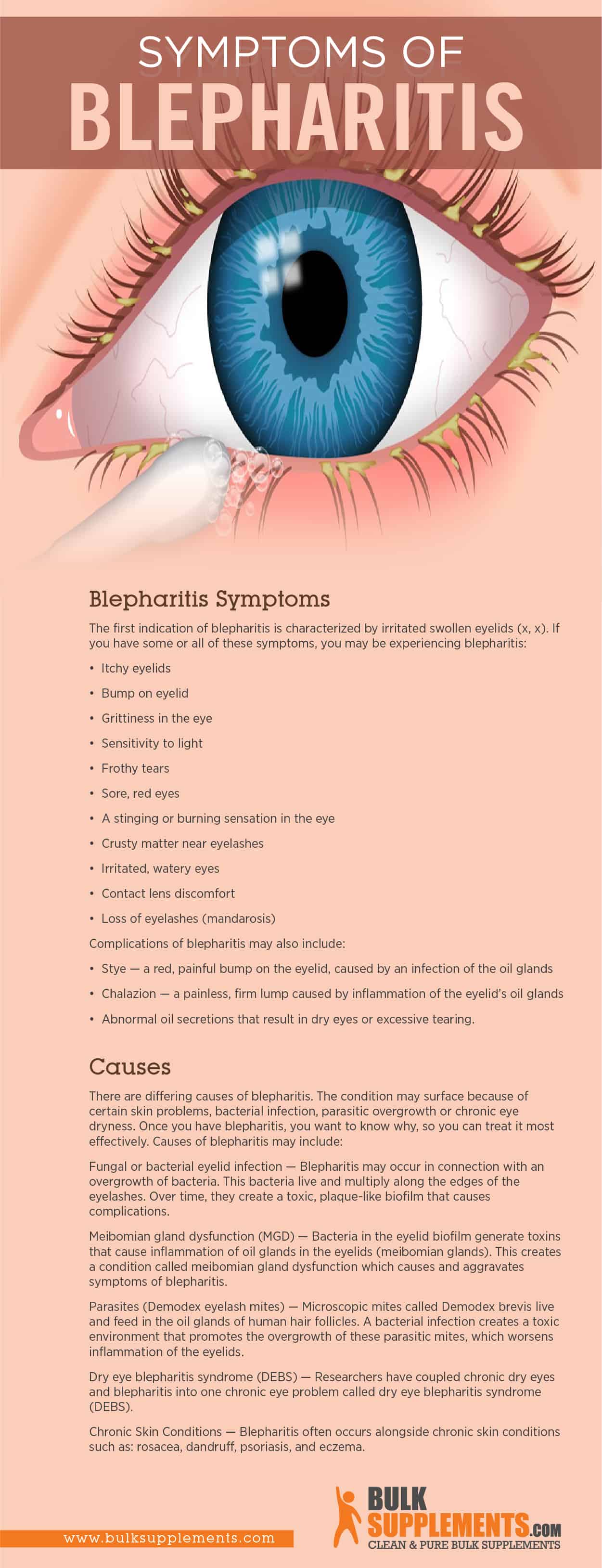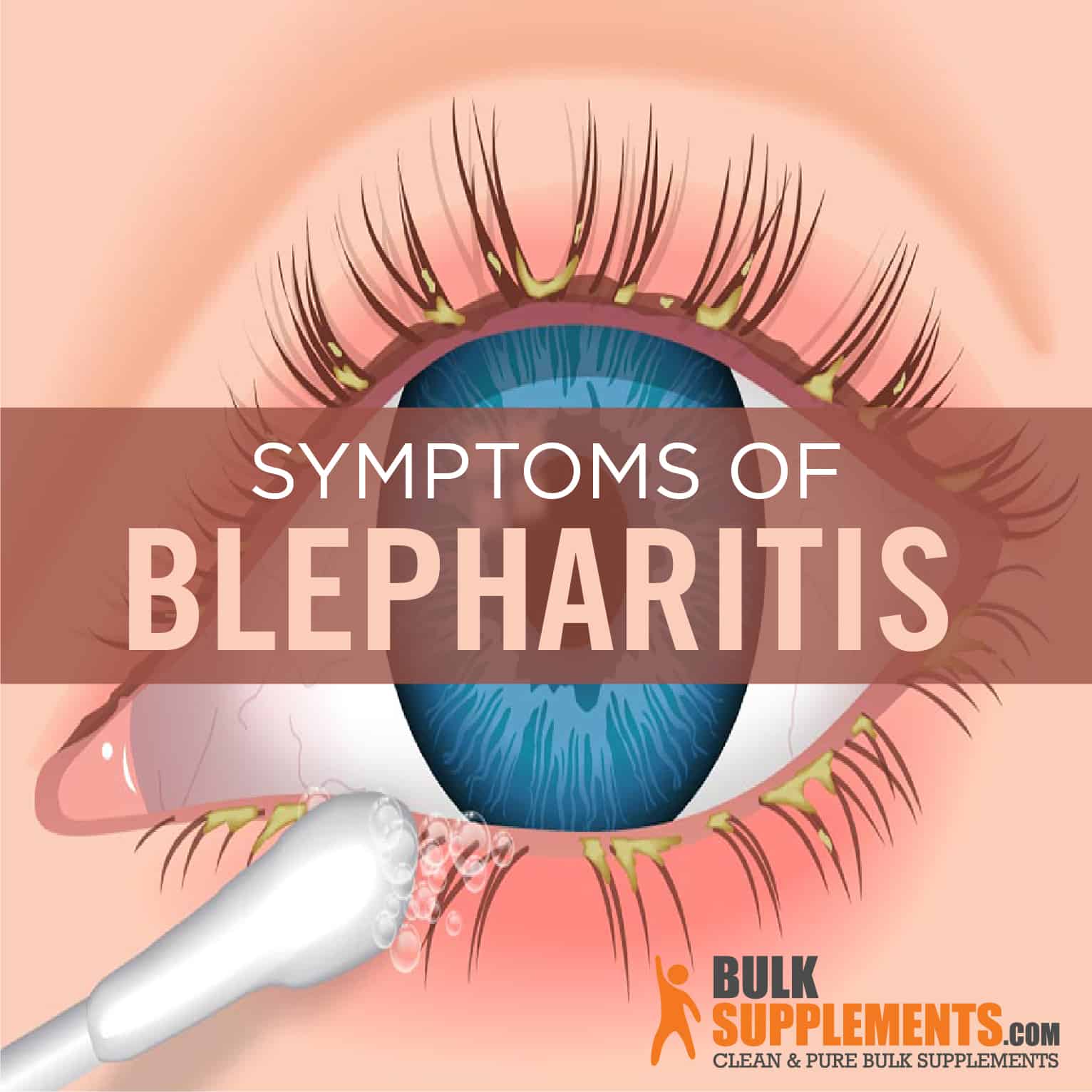What is Blepharitis?
One of the most common eye conditions seen by physicians is blepharitis, which is an inflammation of the eyelids. This condition doesn’t directly threaten eyesight, but left untreated, it may lead to visual sensitivity or permanently damaged parts of the eye structure. Blepharitis can be a nuisance and may begin with the development of a stye and a lump caused by inflammation of the oil glands.
This condition can impact individuals of all ages, especially if they already have an inflammatory skin ailment such as dermatitis, rosacea or eczema. In any event, when you have bacteria and oil flakes at the base of your eyelashes, it is a sure sign of blepharitis. (x). There are various symptoms associated with blepharitis, including, eyelid swelling, persistent dry eyes, and it is often caused by a parasitic infection that attacks the oil glands close to the eye.
There are two different areas where blepharitis exists:
- Anterior blepharitis — This affects the outer area of the eyelid, where the eyelashes attach to the eye
- Posterior blepharitis — This affects the inner portion of the eyelid, where it touches the eyeball
There are two types of blepharitis that people may experience:
- Acute blepharitis — usually caused by a bacterial infection of the eyelid area, or by an allergic reaction
- Chronic blepharitis — an inflammation that often results from other conditions, such as skin disorders that affect the face and scalp (x).
Blepharitis Symptoms
The first indication of blepharitis is characterized by irritated swollen eyelids (x, x). If you have some or all of these symptoms, you may be experiencing blepharitis:
- Itchy eyelids
- Bump on eyelid
- Grittiness in the eye
- Sensitivity to light
- Frothy tears
- Sore, red eyes
- A stinging or burning sensation in the eye
- Crusty matter near eyelashes
- Irritated, watery eyes
- Contact lens discomfort
- Loss of eyelashes (mandarosis)
Complications of blepharitis may also include:
- Stye — a red, painful bump on the eyelid, caused by an infection of the oil glands
- Chalazion — a painless, firm lump caused by inflammation of the eyelid’s oil glands
- Abnormal oil secretions that result in dry eyes or excessive tearing (x)
Causes
There are differing causes of blepharitis. The condition may surface because of certain skin problems, bacterial infection, parasitic overgrowth or chronic eye dryness. Once you have blepharitis, you want to know why, so you can treat it most effectively. Causes of blepharitis may include:
Fungal or bacterial eyelid infection — Blepharitis may occur in connection with an overgrowth of bacteria. This bacteria live and multiply along the edges of the eyelashes. Over time, they create a toxic, plaque-like biofilm that causes complications.
Meibomian gland dysfunction (MGD) — Bacteria in the eyelid biofilm generate toxins that cause inflammation of oil glands in the eyelids (meibomian glands). This creates a condition called meibomian gland dysfunction which causes and aggravates symptoms of blepharitis.
Parasites (Demodex eyelash mites) — Microscopic mites called Demodex brevis live and feed in the oil glands of human hair follicles. A bacterial infection creates a toxic environment that promotes the overgrowth of these parasitic mites, which worsens inflammation of the eyelids (x).
Dry eye blepharitis syndrome (DEBS) — Researchers have coupled chronic dry eyes and blepharitis into one chronic eye problem called dry eye blepharitis syndrome (DEBS) (x).
Chronic Skin Conditions — Blepharitis often occurs alongside chronic skin conditions such as: rosacea, dandruff, psoriasis, and eczema (x).

Preventing Blepharitis
Standard Blepharitis Treatment
The National Eye Institute recommends this standard treatment for chronic or acute blepharitis:
- Keep eyelids clean and free of crusty residue.
- Place warm compresses on the eyelids.
- Lightly scrub the eyelid with a cotton swab and a mixture of water and baby shampoo.
- Continue this treatment as a lifelong routine, since blepharitis often returns.
- If blepharitis persists, see a doctor, who may prescribe antibiotics or other medication (x).
Furthermore, it is important to keep your eyelids, skin and hair clean. In fact, you may safely wash your hair with baby shampoo and use antiseptic sprays on your skin to prevent bacteria from growing too much. Good health begins with maintaining good hygiene.
Treating Blepharitis Caused by Demodex Mites
Demodex mites live in human hair follicles, but we don’t usually notice them. However, if these parasites increase excessively, they can trigger symptoms. You can treat blepharitis by (x):
- Washing the face twice daily with a gentle, non-soap cleanser. Scrubbing the eyelids with baby shampoo may also help.
- Avoiding greasy makeup and oil based cleansers.
- Exfoliate regularly to remove dead skin cells. Use a clean face brush and brush your skin in small, gentle, circular strokes. Rinse your face with lukewarm water.
- A health professional may prescribe a topical or oral medication when an infestation cannot be controlled by home remedies (x).
Treating Blepharitis with Other Issues
Treating blepharitis effectively may involve additional steps for some patients.
- A dandruff shampoo is recommended if scalp dandruff exists.
- Patients with posterior blepharitis should massage the eyelids to dislodge excess oil that has accumulated in the eyelid glands.
- Acne rosacea should be treated while treating blepharitis (x).
For the most part, keeping the lids free of crusts and clean with warm compresses is the key to maintaining good eyelid hygiene. Ultimately, good hygiene can help control blepharitis.
Ongoing Blepharitis Treatment
Keeping your eyelids clean is important for controlling blepharitis. For a routine of good hygiene in the eye area, remember to:
- Wash your hands
- Dampen a clean washcloth with very warm water
- Place the cloth over your closed eyes for several minutes (this softens oils and residue)
- Gently rub your eyelid area with the washcloth before opening your eyes.
- For ongoing prevention of blepharitis, follow this routine once daily, or as directed by a doctor (x)
Supplements for Eye Health
We don’t often think too much about our eyes, until a speck in one eye plagues us, or until a condition like blepharitis surfaces. A regular eye care routine is a good idea, but on top of that, here are some nutrients that give special care to the eyes:
- Omega-3 Fatty Acids — Help form eye cells and carry anti-inflammatory properties which may prevent diabetic retinopathy (x). In fact, Studies involving pre-term and full-infants suggest that consuming enough omega-3 fatty acids in the diet is important to visual development (x).
- Beta carotene — Plays a critical role in supporting the cornea, the outside covering of the eye. Beta carotene is a factor in the protein that supports night vision and a diet rich in this nutrient may reduce risk of macular degeneration (x). Indeed, Beta carotene and vitamin A help to reduce the risk of eye infections.
- Vitamin C — Is a high quality antioxidant, which the eye needs for its high metabolic rate (x). With this in mind, vitamin C is also important for maintaining the health of blood vessels in the eyes.
- Zinc — Is important in maintaining the health of the retina (x).
Zinc can reduce the risk of age-related macular degeneration and, most notably, slow down the progression of a disease associated with vision loss. - Lutein and Zeaxanthin — These two antioxidants may limit oxidative damage in the retina (x). Indeed, these two carotenoids help protect and maintain healthy cells in the eyes.
The Bottom Line
Blepharitis will not cause permanent damage; however it can be chronic. As a matter of fact, the condition can lead to more severe symptoms. Blepharitis is associated with a bacterial eye infection, dry eye symptoms and certain skin conditions. However, it is important to realize that it is often caused by oil glands within the eyelid.
To clarify, blepharitis can be managed with a simple regimen of eye care. However, if this routine doesn’t eradicate the condition, a health professional can prescribe antibiotics or other treatments to manage this common eye problem.


